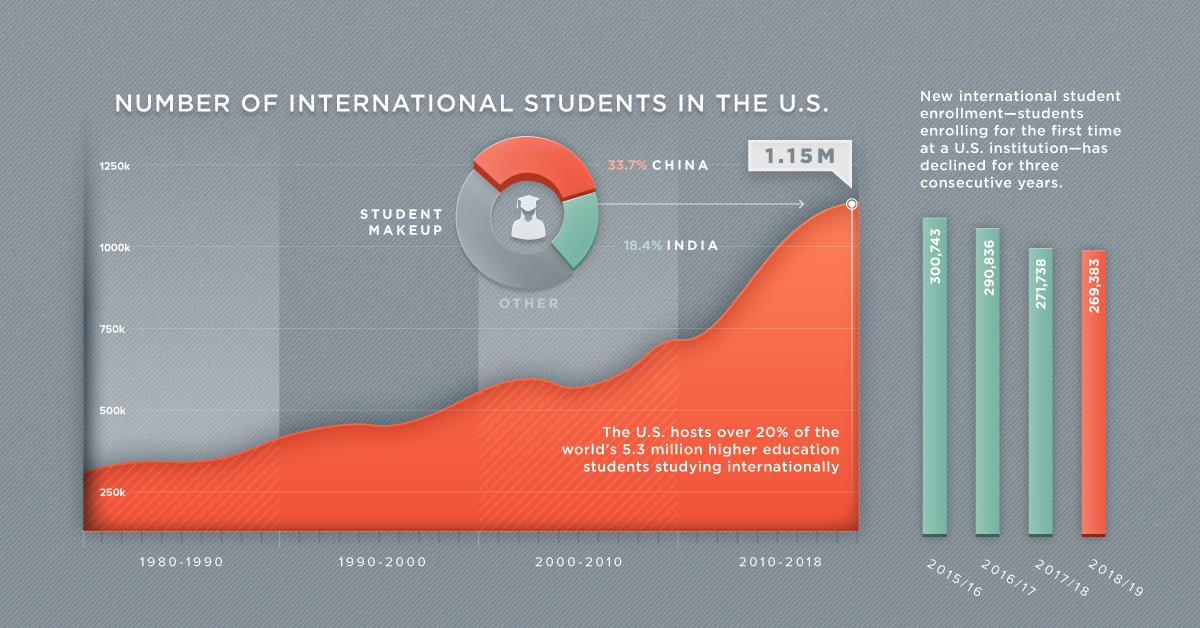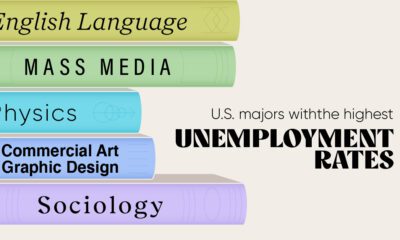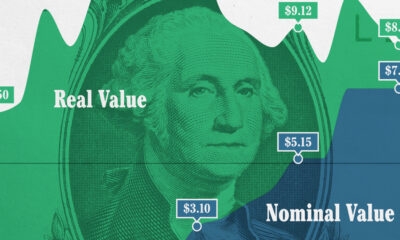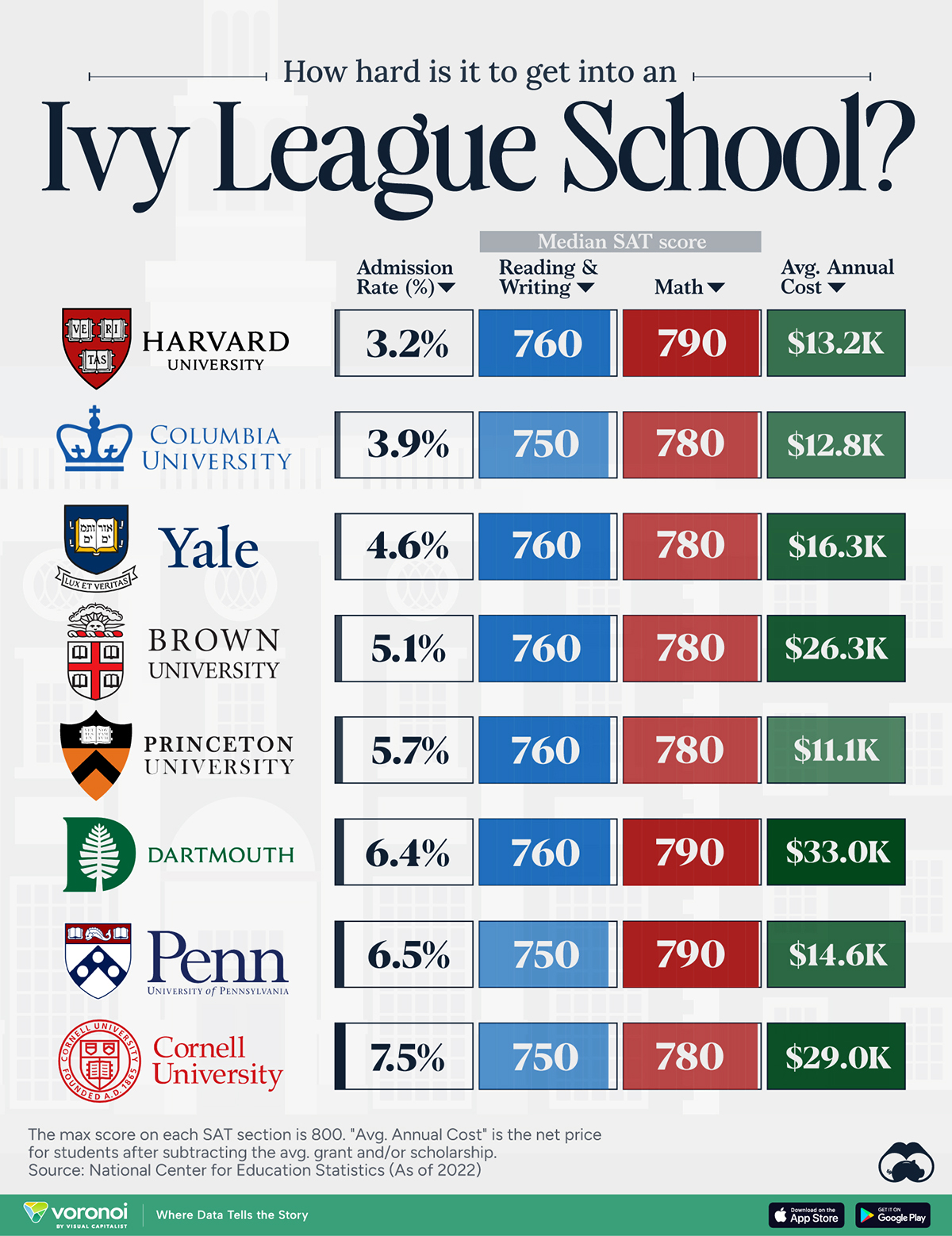Misc
The Impact of International Students on the U.S. Economy

The Economic Impact of America’s International Students
For decades, the U.S. has been the top destination for students looking to study abroad.
It’s easy to see why. Not only does the country provide access to world-class economic hubs like Silicon Valley, but the U.S. is also home to 14 of the top 20 universities in the world, many of which are famed for their research and alumni networks.
Yet, there is cause for concern.
International enrollments in the U.S. have slowed, while other countries are attracting a larger share of the global talent pool. To help us understand what’s at stake if enrollments continue to decline, today’s infographic shows the impact of international students on the U.S. economy.
Driving American Innovation and Growth
International students and scholars are a vital economic asset, and America’s ability to attract them puts the country in an enviable position.
First, there are the direct economic benefits which result from tuition fees and living expenses. Throughout the 2018/2019 school year, these benefits totaled $41 billion, a comparable value to many other American exports:
| Export | Value (2018) |
|---|---|
| Automobiles | $158B |
| Commercial Aircraft | $131B |
| Pharmaceuticals | $51B |
| Education Exports | $41B |
| Telecommunications Equipment | $36B |
| Soybeans | $17B |
Source: NAFSA, Evans, WorldCity
Even after graduation, however, international students and scholars continue to make significant contributions to the U.S. economy.
For example, attracting the world’s brightest minds helps to grow the knowledge economy in the United States, and 40% of American Nobel Prizes won in chemistry, medicine, and physics since 2000 have been awarded to immigrants. Furthermore, students who return home often do so with a network of connections and an appreciation for American culture, thus promoting U.S. international leadership.
Finally, these individuals can also go on to become successful entrepreneurs and business leaders in the U.S. economy. The list is long, but here are two noteworthy examples:
- Elon Musk, known for founding Paypal, Tesla, and SpaceX, was born in South Africa. He received two Bachelor’s degrees from the University of Pennsylvania before founding his first business.
- Satya Nadella, CEO of Microsoft, was an international student from India. He received an M.S. from the University of Wisconsin and an MBA from the University of Chicago before helping Microsoft develop its cloud computing capabilities.
Cause for Concern
In recent years, however, the number of new international students enrolling at U.S. institutions has been on the decline:
| School Year | New International Student Enrollments in the U.S. | Percent Change |
|---|---|---|
| 2013/14 | 270,128 | -- |
| 2014/15 | 293,766 | 8.8% |
| 2015/16 | 300,743 | 2.4% |
| 2016/17 | 290,836 | -3.3% |
| 2017/18 | 271,738 | -6.6% |
| 2018/19 | 269,383 | -0.9% |
Source: Institute of International Education
With so many opportunities and success stories, why have international enrollments slowed? A survey of 509 higher education institutions in the U.S. revealed the top reasons for declining international enrollments:
| Cited Reason for Decline in Enrollment | % of Institutions (Fall 2016) | % of Institutions (Fall 2017) | % of Institutions (Fall 2018) |
|---|---|---|---|
| Visa Application Process (delays/denials) | 34% | 68% | 83% |
| Social and Political Environment | 15% | 57% | 60% |
| Enroll in Another Country’s Institutions | 19% | 54% | 59% |
| Cost of Tuition | 51% | 55% | 57% |
| Feeling Unwelcome | - | 49% | 50% |
| Securing a Job | - | 41% | 44% |
| Physical Safety | 12% | 33% | 44% |
Source: NAFSA
Critically, the two most common reasons for declining enrollment—visa applications and the social and political environment—suggest that the quality of an American education is not the issue. Rather, it would appear that students are being discouraged from coming to the United States.
When we discourage or turn away international students, we lose much more than the students themselves… We lose their inventions and innovation, their collaborative input and their contributions to our communities.
– Dr. Martha E. Pollack, President, Cornell University
At the same time, other countries are taking proactive measures to attract global talent.
Australia
Australia allows its international students to work for up to 18 months after graduation. This limit can increase to 4 years for graduates of high-demand occupations. In 2018, the country saw a 15% increase in international enrollments.
Canada
Canada, a country distinguished for its multiculturalism, is quickly becoming an attractive destination for international students. The country offers expedited visa processing for qualified individuals, as well as a 3-year work visa for graduates. In 2017, international enrollments in Canada grew by an impressive 20%.
Potential Consequences
The world’s brightest minds are an important asset for continued innovation and growth, and today, there is a mass of countries welcoming them with open arms.
While the U.S. is still the preferred destination for international students and scholars, the country’s leadership in this space is at risk. In fact, since 2001, the share of international students in America has fallen from 28% to 21%.
Will the U.S be able to maintain global competitiveness if the number of new international students enrolling continues to fall? Can the country work to cultivate a more welcoming and barrier-free route to higher education?
These are potent questions that will need to be answered, especially with a sizable economic impact on the line.
Misc
How Hard Is It to Get Into an Ivy League School?
We detail the admission rates and average annual cost for Ivy League schools, as well as the median SAT scores required to be accepted.
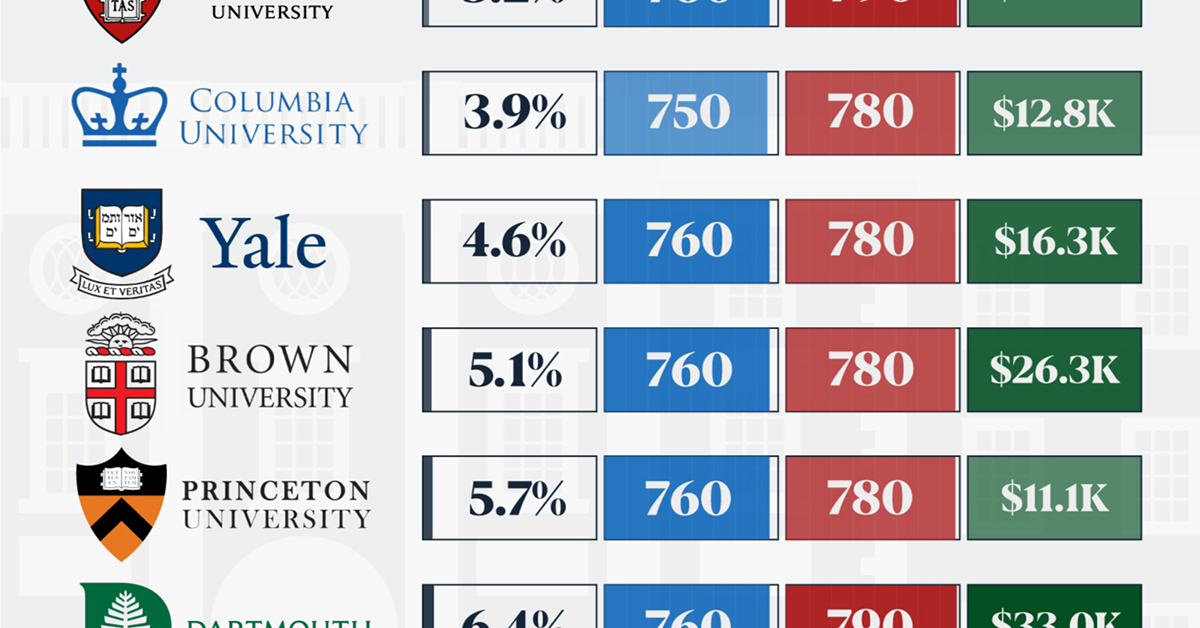
How Hard Is It to Get Into an Ivy League School?
This was originally posted on our Voronoi app. Download the app for free on iOS or Android and discover incredible data-driven charts from a variety of trusted sources.
Ivy League institutions are renowned worldwide for their academic excellence and long-standing traditions. But how hard is it to get into one of the top universities in the U.S.?
In this graphic, we detail the admission rates and average annual cost for Ivy League schools, as well as the median SAT scores required to be accepted. The data comes from the National Center for Education Statistics and was compiled by 24/7 Wall St.
Note that “average annual cost” represents the net price a student pays after subtracting the average value of grants and/or scholarships received.
Harvard is the Most Selective
The SAT is a standardized test commonly used for college admissions in the United States. It’s taken by high school juniors and seniors to assess their readiness for college-level academic work.
When comparing SAT scores, Harvard and Dartmouth are among the most challenging universities to gain admission to. The median SAT scores for their students are 760 for reading and writing and 790 for math. Still, Harvard has half the admission rate (3.2%) compared to Dartmouth (6.4%).
| School | Admission rate (%) | SAT Score: Reading & Writing | SAT Score: Math | Avg Annual Cost* |
|---|---|---|---|---|
| Harvard University | 3.2 | 760 | 790 | $13,259 |
| Columbia University | 3.9 | 750 | 780 | $12,836 |
| Yale University | 4.6 | 760 | 780 | $16,341 |
| Brown University | 5.1 | 760 | 780 | $26,308 |
| Princeton University | 5.7 | 760 | 780 | $11,080 |
| Dartmouth College | 6.4 | 760 | 790 | $33,023 |
| University of Pennsylvania | 6.5 | 750 | 790 | $14,851 |
| Cornell University | 7.5 | 750 | 780 | $29,011 |
*Costs after receiving federal financial aid.
Additionally, Dartmouth has the highest average annual cost at $33,000. Princeton has the lowest at $11,100.
While student debt has surged in the United States in recent years, hitting $1.73 trillion in 2023, the worth of obtaining a degree from any of the schools listed surpasses mere academics. This is evidenced by the substantial incomes earned by former students.
Harvard grads, for example, have the highest average starting salary in the country, at $91,700.
-

 Green2 weeks ago
Green2 weeks agoRanked: Top Countries by Total Forest Loss Since 2001
-

 Travel1 week ago
Travel1 week agoRanked: The World’s Top Flight Routes, by Revenue
-

 Technology1 week ago
Technology1 week agoRanked: Semiconductor Companies by Industry Revenue Share
-

 Money2 weeks ago
Money2 weeks agoWhich States Have the Highest Minimum Wage in America?
-

 Real Estate2 weeks ago
Real Estate2 weeks agoRanked: The Most Valuable Housing Markets in America
-

 Markets2 weeks ago
Markets2 weeks agoCharted: Big Four Market Share by S&P 500 Audits
-

 AI2 weeks ago
AI2 weeks agoThe Stock Performance of U.S. Chipmakers So Far in 2024
-

 Automotive2 weeks ago
Automotive2 weeks agoAlmost Every EV Stock is Down After Q1 2024

